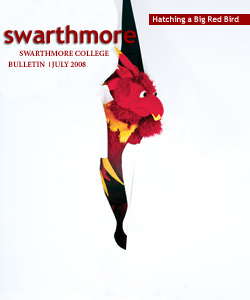College Seeks to Cull Crum Deer
In April, the College announced that it will seek amendments to local ordinances and the necessary permits from the Pennsylvania Game Commission to reduce the deer population in the Crum Woods. If permissions are granted, professional sharpshooters will be hired to remove an as-yet-unknown number of deer during the College’s winter break in December 2008 and January 2009. The venison from the culled animals will be donated to local groups that feed persons in need.
The action comes after years of study of the ecosystem of the College’s 220-acre forest by the Crum Woods Stewardship Committee (CWSC), composed of faculty, staff, and students. The committee concluded that among the various threats to the future health of the forest, deer overpopulation was the most serious. According to its February report to the community, “excessive deer browsing is limiting the ability of the forest to regenerate naturally. Consequently, as large trees die, no seedlings are available to replace them.” This conclusion is based on a 2003 conservation and stewardship plan commissioned by the CWSC and conducted by Natural Lands Trust and Continental Conservation, which characterized the effect of deer overpopulation as “profound.”
In November 2005, the College conducted an aerial infrared survey of the deer population in the Crum Woods and surrounding areas. That count estimated a minimum population of 29 deer per square mile. Based on the imperfect science of such aerial surveys, it was estimated that the actual population is likely 40 to 60 percent higher than that.
The CWSC recommended the use of sharpshooters after considering numerous options, including trapping and removal of deer and the use of experimental contraception techniques. Other methods, such as recreational hunting or the restoration of natural predators such as cougars, were dismissed because of concerns about safety in the College’s suburban setting. These and other options were examined and presented in 2007 by Natural Resource Consultants, Inc., which made the initial recommendation in favor of the sharpshoot.
Following a discussion of the draft CWSC recommendation by the Board of Managers in December 2007 and the report’s public release in February, the committee held separate forums for faculty, staff, and students to air their recommendations. Associate Professor of Biology José-Luis Machado, co-chair of the committee, describes the campus reaction as “99 percent positive and supportive of the initiative because of the recognition of its potential impact in regenerating the woods.”
Machado’s ecology classes regularly use the Crum as an outdoor teaching laboratory. A 2001 survey of faculty members conducted by the CWSC found that 35 courses in 12 different academic departments have used the woodlands as a resource in recent years.
The College will seek amendments to firearms ordinances from both the Borough of Swarthmore and Nether Providence Township. Then the two local governments and the College will petition the Pennsylvania Game Commission for a permit to conduct the cull, which will be carried out by trained personnel at pre-approved sites—most likely at night—under strict safety regulations. Other nearby communities that have adopted this deer-cull technique include the Wissahickon Valley, Pennypack, and West Fairmount parks.
The full committee statement on deer management is on the Web at www.swarthmore.edu/cwsc_rec.xml. Answers to frequently asked questions about the deer cull can be found at www.swarthmore.edu/deerfaq.xml.
 Email This Page
Email This Page